An abandoned school in rural Japan becomes a shrine to the concept of mottainai.
Through a dusty window at Mukoyama-Kita Elementary School, you can see a chalkboard covered in pastel scribbles of Snoopy and Anpanman, the Japanese kid’s hero whose head is made out of a red bean-stuffed bun. Mustachioed former principals sternly suppress smiles from rows of faded black-and-white portraits in the office. In the gym, the flags of Japan, Miyazaki Prefecture, and the town of Takachiho hang side by side. Mukoyama-Kita Elementary closed in 2010 when it had only 15 students left. One third of schools in the town have had to shut down in the last decade due to a shrinking population.
Although a school lunch hasn’t been served here in six years, Sayomi Sakamoto is peeling vegetables in a small outbuilding next to the gym. Behind her, on a shelf above a cash register there’s a Shinto altar. A paper Buddhist charm hangs on the wall to protect against kitchen fire.
With the sleeves of her indigo kasuri blouse pushed up to the elbows and a bundle of green stalks wrapped in newspaper on the counter beside her, she holds a stem in one hand and deftly strips off a fibrous ribbon, like de-stringing celery. These are kabocha no kuki, Japanese pumpkin vines. Kabocha, smaller and sweeter than the Jack-o’-lantern kind of pumpkin, is used year-round in Japanese cooking, but most people just throw out its prickly vines. Sakamoto will stir-fry and simmer them with soy sauce, sugar and chili pepper, a variation of the classic dish kinpira.
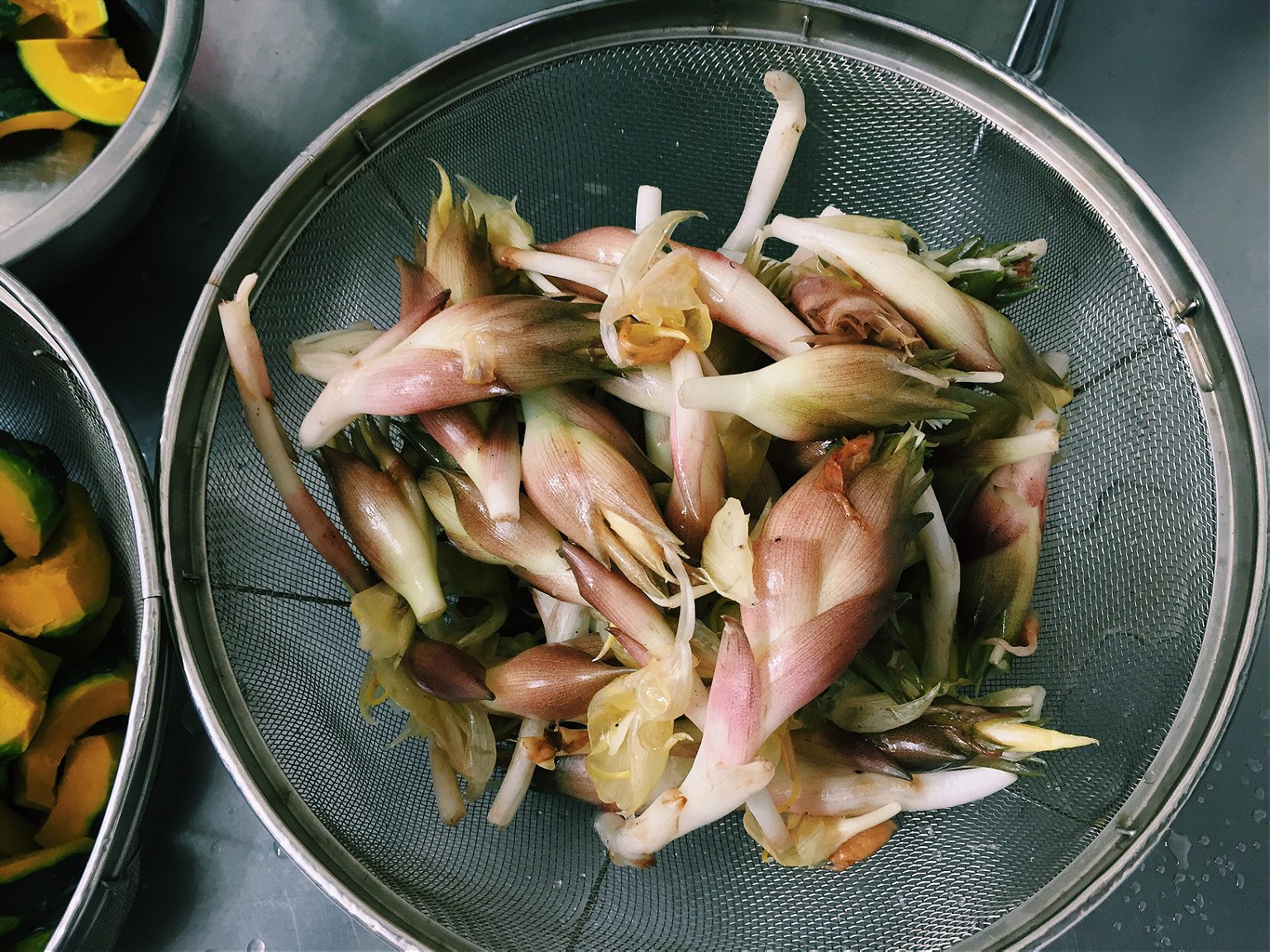
Her impulse to use the unwanted part of the vegetable can be ascribed to mottainai, the Japanese ethos of not letting anything—especially anything edible—go to waste. Often translated as ‘waste not, want not,’ mottainai is a phrase used by moms to get kids to scrape every grain of rice from their bowl, and it was used by Sakamoto’s husband when, three years ago, he was helping to weed Mukoyama-Kita’s overgrown school playground.
Mr Sakamoto looked up from his work to take in the view: lush trees disappearing into a river gorge, an arched bridge leading across to a storybook village, graduated layers of blue-green mountains retreating into the distance. Mottainai: what a waste of a view and a school building. “He gave me no choice but to open a restaurant here,” says Sakamoto.
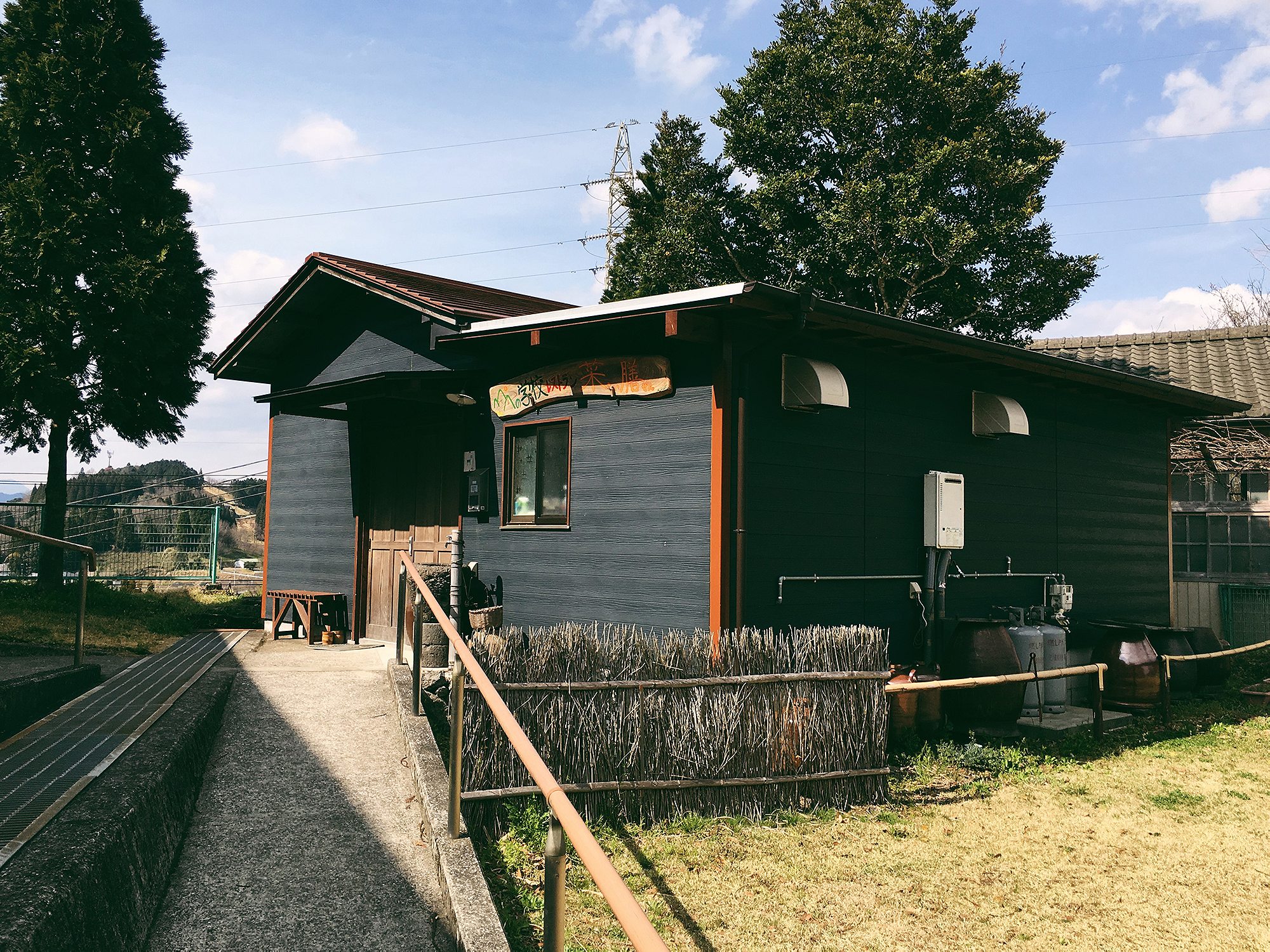
Saizen Mountain School Restaurant only has three tables, and serves lunch by reservation for only three hours a day. Sakamoto and her partner, Mahomi Uchikura, are preserving the art of sansai ryouri, wild mountain vegetable cuisine. Some of their ingredients are grown in Sakamoto’s garden, but almost all of the rest are sansai foraged from the surrounding countryside–roots, stems, shoots, buds, and leaves.
The name Saizen is written with two characters: the first, sai, means ‘vegetable, side dish or greens’ the second, zen, means ‘meal or dining table.’ Saizen Mountain School Restaurant might have been inspired by the view, but it’s hard to imagine looking out the window once your meal is in front of you.
Saizen’s set menu rotates with the season and whatever Uchikura, the resident sansai expert, happens to stumble upon on her daily foraging trips. Today, in mid-summer, they’re serving a puffed millet cake that’s at once crunchy like popcorn and gelatinous like mochi, as well as sweet morsels of steamed kabocha, a mound of bitter blanched mustard greens sprinkled with sesame seeds, shavings of Japanese knotweed laced with saffron-like threads of togarashi pepper and a sliver of fried rainbow trout caught in the river at the bottom of the gorge dressed in a tangy sauce.
Even Saizen’s rice, the staple of every Japanese meal, isn’t constant: glutinous purple heirloom rice in summer, studded with hearty walnuts and chunks of sweet potato in fall and winter. In spring, the grains are perfumed with bamboo shoots, and they might be served alongside stir-fried fiddleheads of warabi fern, tara no me (angelica buds) with vinegar, and the indelible symbol of the season, sakura: diaphanous cherry blossoms floating in a clear broth.
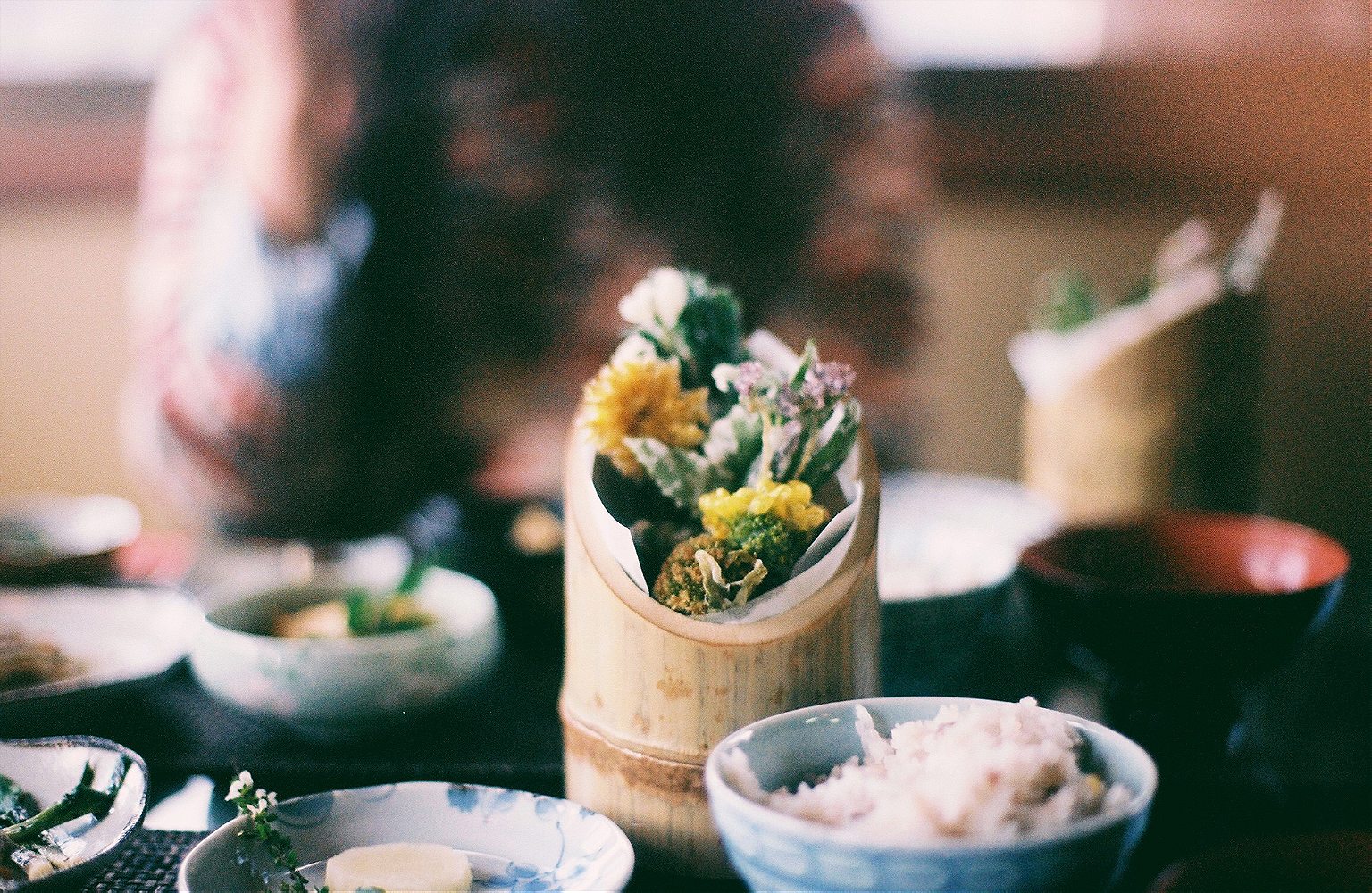
Flowers aren’t just decorative elements on Saizen’s table—they star in the tempura, a bouquet of yasou, wildflowers and edible grasses, presented in a bamboo vase. Feather-light leaves, dandelions, lavender-like utsubo florets, squash blossoms, and butterbur bulbs are encased in a brittle layer of batter, like buds perfectly preserved by a sudden ice storm.
Sometimes Sakamoto will loop a blade of grass into a knot before frying it to a crisp. Dipped into a dusting of matcha salt, the effect is as pleasure-center-satisfying as a good potato chip, but elevated. It’s the dish that most surprises customers from out of town, Sakamoto says, because you can’t find anything like it, even in Tokyo or Osaka.
When guests see that she’s even tempura-fried goldenrod, an invasive weed that covers the roadside with froths of yellow flowers every fall, they react with disbelief: “Can you really eat this?” The idea for flower tempura, she says, came to her one day when she noticed the appetizingly vivid color of a violet and it was like “god fell down to me.”
The five elemental Japanese seasonings can be remembered as “sa shi su se so”: sa for sato, sugar; shi for shio, salt; su for su, vinegar; se for seuyu/shoyu, soy sauce; so for miso. Since the use of sugar means that many of the vegetable dishes are already slightly sweet, Saizen’s dessert isn’t a sugarbomb. At the bottom of the handwritten signboard that serves as Saizen’s menu, the dessert section says only, “Look forward to it!” Depending on the day, it could be dense sweet potato cake, mild and creamy matcha pudding, slices of jellied youkan made with chestnuts grown in a neighboring town, stewed plums, or, in late winter when the local citrus is at its peak, a single whipped cream-filled kumquat.
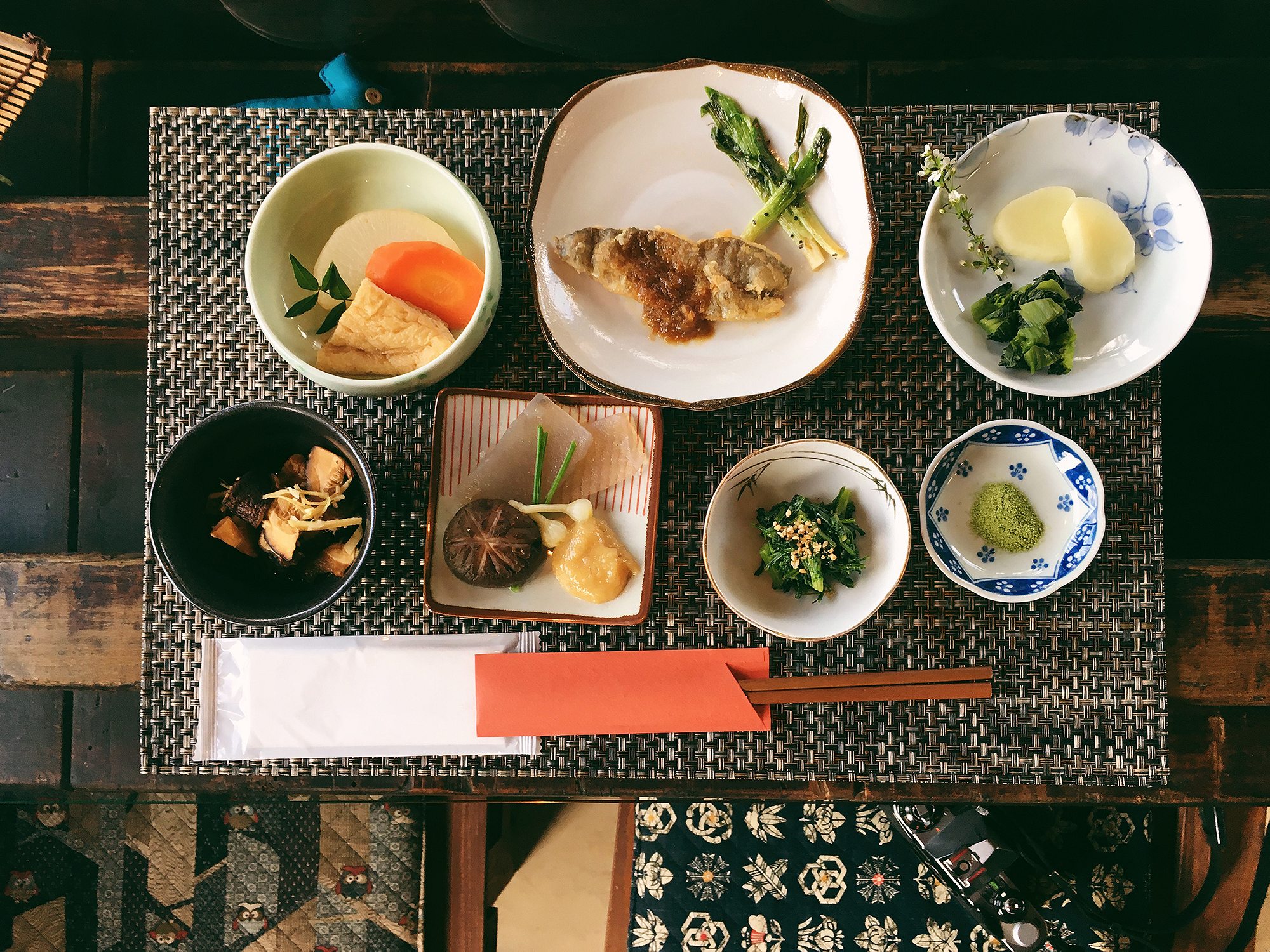
Before she opened Saizen three years ago, Sakamoto was working in one of the ryokans that serve the busloads of domestic sightseers who come to see Takachiho’s postcard-perfect river gorge. Like the rest of Kyushu, Takachiho Gorge isn’t on most foreign tourists’ radars, though you might have seen it without knowing. A waterfall pours between two impossibly geometric chiseled rock walls into emerald water below, where ducks paddle and couples bump into one another in rented rowboats. The image has been used to lend a feeling of idyll to computer desktops and the covers of new age music albums.
Sakamoto knew that there was a demand among out-of-towners for a delicacy they could find only in Takachiho. Each region in Japan has its own specialty, and tourists will go the distance to get the real thing. Miyazaki Prefecture’s thing is mangos, though they’re prohibitively expensive and many locals have never even tasted one. Sunset red, unblemished and symmetrical, a coveted, first-of-the-season pair were auctioned for $2,500 in 2015. But Takachiho is tucked up in the mountains, removed from the rest of Miyazaki’s tropical climate, and the only mangos you’ll find are gift-wrapped in grocery stores and cost more than $20 each.
Takachiho is also proud of its beef, made prize-winningly sweet and tender by a life spent pampered inside barns (the steep mountainsides don’t offer much wide open space for pasture). But even the beef loses some of its Takachiho-exclusive cache because many of the cattle raised here are sold to Kansai farmers where their meat gets rebranded as the much more glamorous Kobe beef. Plus, says Sakamoto, you can eat Takachiho beef anywhere—gyudon beef bowls and juicy grilled cuts are ubiquitous at local eateries.
So she turned to the past to find the uniquely Takachiho flavor she was looking for. Sansai are eaten all over Japan, most commonly in sansai soba, a buckwheat noodle soup topped with mushrooms and mountain vegetables. But the availability and methods of preparing sansai vary regionally and their secrets are largely passed informally from generation to generation—so no two local sansai cooking cultures are the same.
The tastier the wild grasses are, the more similar they are to the poisonous ones
Takachiho’s isolated geography makes its tradition of mountain vegetables especially rich. Smack-dab in the center of Japan’s southern island Kyushu, the nearest train station is an hour away (the local railway was wiped out in a record-breaking typhoon in 2005 and was too costly to replace). If the town seems cut off now, one can only imagine how remote it must have been before the advent of dynamited tunnels and gorge-spanning bridges. Under these conditions, fresh fish and meat weren’t readily available, and so the local cuisine grew up around scavenged mountain vegetables.
Spring is of course the best season for sansai, when they’re so abundant that you’ll see Japanese grandmas bent over alongside the road, filling plastic bags with shoots. But Uchikura, Saizen’s resident sansai expert, knows where to find wild things to eat even in winter.

Uchikura learned about sansai from her grandmother, who came from Gokase, an even sleepier town just over the mountains. Recently, a few sansai have been successfully cultivated, but those are expensive and limited. So every morning Uchikura searches the countryside around her house or along the Roppo Gaido (Six Peaks Road), an ancient skyline route linking the region’s mountain villages. There has never been a day when she turned up at the restaurant empty-handed.
Sometimes when Uchikura is foraging, she’ll stoop down to taste something and then quickly straighten up and spit it out. That’s because “an interesting thing about good sansai is that they often grow next to another kind of plant that looks similar, but is poisonous,” explains Sakamoto.
“The tastier the wild grasses are, the more similar they are to the poisonous ones.” She and Uchikura aren’t sure why this is, but they have two ideas. One is safety; the sansai want to protect themselves from being eaten by imitating the poisonous plants. The other reason is that sansai’s deliciousness is so attractive to the seed-spreading animals who want to eat them, that the poisonous plants mimic them.
Even in winter, when sansai are more scarce and Saizen has to rely more on what they can grow, Sakamoto’s focus is always using vegetables in unexpected ways. Recently she introduced her recipe for karaage-style fried daikon on NHK TV. She marinates the radish in garlic and soy sauce, then coats it in panko and fries it to a crisp. In fact, though Saizen’s meals are an homage to traditional ways of eating, the emphasis is always on creativity and originality. She shuns katuso-dashi, the ubiquitous bonito fish stock which is used in practically every Japanese preparation. “Katsuo has a strong flavor, so it doesn’t suit the sansai well,” she explains. “Normal households tend to use that flavor often as a stock, so if I use katsuo my dishes will just taste ordinary.”
Instead, she gleans ideas from foreign cuisine. “I love French and Italian food, and when I’m eating it I’ll think ‘Oh, could I substitute sansai here?’” That’s how she turned shiitake mushrooms, which sprout from damp logs in Takachiho’s shady forests, into a faux escargot made with garlic, butter, and anchovy. Another fusion is her bamboo shoot teriyaki, flavored with soy sauce, sugar, and an unorthodox splash of balsamic vinegar. These twists help bridge the gap between traditional ingredients and contemporary tastes for the customers who come from the big city to hike the 12 km Takachiho Olle course, which passes right by Mukoyama-Kita Elementary.

Young urbanites who prefer rich, convenient grub like ramen and katsu (fried pork cutlets) tend to be out of touch with sansai ryouri, Sakamoto says, but Saizen’s menu actually reflects the way that all Japanese people used to eat. In fact, she insists that the island’s history of a grain- and vegetable-based diet has resulted in Japanese people having longer intestines than their Western counterparts (the scientific jury seems to still be out on this claim) and that a return to tradition could stave off modern diseases.
“We think people who eat our food will rediscover the goodness of sansai,” she says, “because the day after they eat at Saizen they will have a good, healthy poo.”
She can say this with confidence, because Sakamoto herself is a sansai convert. She came to Takachiho as a bride 30 years ago, but was raised in a small fishing village on the coast. She was drawn to sansai because she appreciated the wisdom that goes into finding them and the effort it takes to make them edible. “Fish are easy to cook. We don’t have to do anything to make them taste good—just bake them,” she says. “But with sansai, the more steps we take, the more we use our hands to cook or braise or pickle them, the tastier they get.”
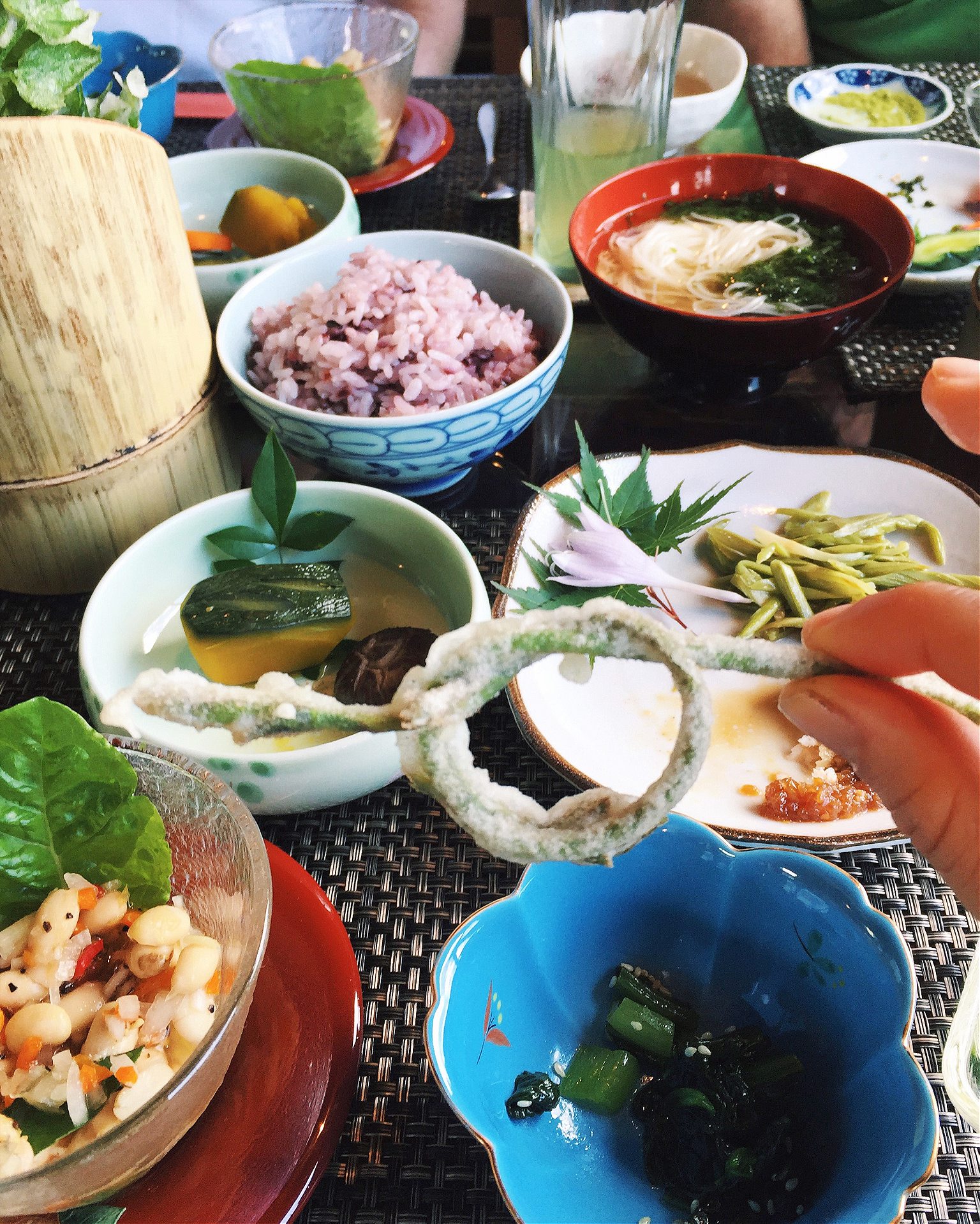
That’s because mountain vegetables have a lot of what the Japanese call aku—harshness, bitterness, or astringency—which has to be removed before you can eat them. In the old days, this was done by boiling sansai with wood ash, but modern cooks usually soak or boil them with soda overnight. The tediousness of sansai does beg the question: why did people ever bother to eat them in the first place? “We talk about that all the time,” says Sakamoto, gesturing to herself and Uchikura. “How did the people in the old days even figure this all out? We think it’s because they had to, to survive.”
With a set lunch usually topping out at a bountiful 10 separate dishes, Saizen is definitely not survivalist fare—although for less than $12, it’s no extravagance either. But locating it does take effort. First you have to make the trek to Takachiho, then cross a dizzyingly high bridge to get to Mukoyama (which literally means ‘that mountain over there’) wind around an empty road with exactly 11 curves, and arrive at the small shack in the back of an abandoned elementary school.
It’s a bit like finding a tender wild shoot among the weeds.
Top image by Alex Thomas. See more of her work on Instagram.